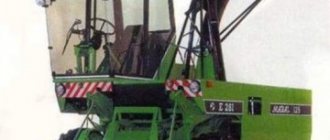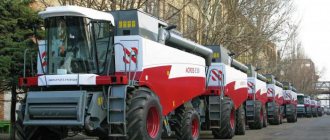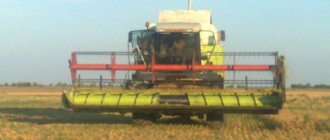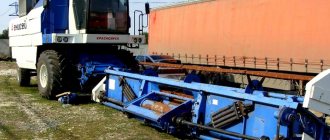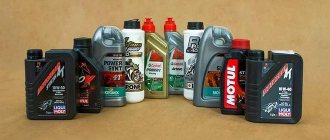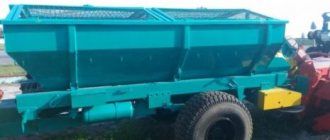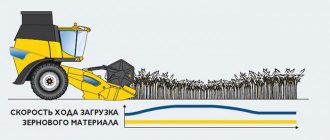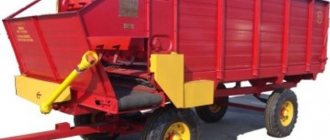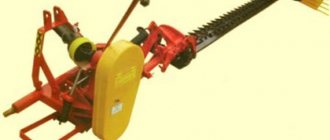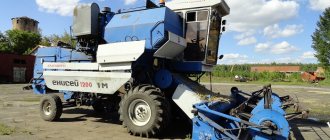The legendary “four” of the SK series of self-propelled combines of the Soviet period in 1962 replaced the previous model SK3. The new product featured a more powerful engine. The combine harvester, well known in the USSR and beyond, was produced until 1974. He has received awards from numerous exhibitions. Awarded a 1st degree diploma, a gold medal and a silver cup at the international trade fairs of Leipzig, Brno and Budapest. In just 12 years, more than 855 thousand copies of this model were produced. Newspapers called the SK 4 a self-propelled “steppe ship,” and in the West the model was respectfully called the “king of combine harvesters.” For the development of the combine, the team of the special design bureau GSKB (Taganrog), headed by the famous designer Kh.I. Isakson was awarded the Lenin Prize. This was a huge victory for the Don machine builders. At that time, only outstanding developments that were of great economic importance for the country were awarded such a high award (photo of the SK 4 combine).
Combine harvester SK-4
The unit was developed at the combine plant in the city of Taganrog, in the design bureau under the leadership of Izakson, a famous designer of those times. A few years earlier, the previous model, SK-3, was also created there. A new combine was designed to make it more perfect by eliminating some shortcomings. It was produced for 12 years - from 1962 to 1974.
During this time, its creators were awarded the Lenin Prize, and the machine itself more than once received awards and gold medals at international exhibitions (in Brno, Budapest, Leipzig). The unit was produced simultaneously by two enterprises: in addition to the Taganrog Combine Harvester. And since 1964, assembly was carried out at the Krasnoyarsk Combine Harvester Plant.
Like the SK-3 model, this Niva self-propelled machine was equipped with: a wide thresher (almost 1.2 meters), the ability to adjust the stroke of the working parts while driving, and a hydraulic booster for turning.
However, thanks to the lengthening of the straw walker keys and the use of larger augers with an increased spiral pitch, its productivity has increased by a quarter.
Other units also underwent reconstruction. In particular, the stacker parts have been changed and the elevator scrapers have been enlarged. Photo of the SK-4 combine
Models
The Yenisei-1200-1 and 1200-1M combines have a distinctive feature, which is that they have one drum, and not two, as provided in the base model. These machines are also equipped with an autonomous pre-threshing mechanism. Combines are designed to work in fields with high levels of humidity.
The Yenisei-1200-RM combine harvester has a tracked spring undercarriage. The machine is used to harvest rice. It also perfectly processes other crops where the area is characterized by a high degree of humidity. In addition, the combine is endowed with the following features: the straw walker has high activity due to an increase in the separation area, and the thresher has two different drums, one of which is made with a beater, and the second has a pin configuration. The rotating part of the bridge is made on the basis of a friction transmission.
Models 1200-НМШ and 1200-1НМШ are also used for harvesting soybeans and rice. However, the soil on which these combines operate must be either completely dry or slightly moist, since these machines have wheels rather than tracks.
“Yenisei”-1200-N is equipped with wheels from the powerful T-150 tractor and therefore this combine is characterized by excellent maneuverability. It was developed specifically for servicing non-chernozem fields.
The grain harvester “Yenisei”-1200-1NM since 2003 is an improved version of the basic model with a pair of beater drums. The high-performance and powerful machine, in fact, became a transition bridge between the 1200 and 950 series (Ruslan).
Distinctive features of the combine can be considered a very powerful motor, hydraulic transmission, a reinforced version of the drive axle, and an optimized grain bunker. The thresher received a larger separation area thanks to the extension of the straw walker keys.
Device
Engine
A four-stroke engine with four in-line cylinders made in the form of plug-in sleeves runs on diesel fuel. Fuel supply is carried out directly. Cooling occurs with the help of liquid entering the radiator from the water pump.
A two-stroke carburetor starting motor with one cylinder and a starter is used for starting. It shares common cooling with a diesel engine. Its power take-off, like that of the main engine, occurs on both sides.
Transmission
Power is transferred from the motor to the receiving pulley using a V-belt variator. Its hydraulic cylinder is controlled by a lever. The machine's double-disc clutch is mounted on a receiving pulley. It is constantly closed. Moving forward, you can choose one speed out of three possible. The harvester can only move backwards at one speed.
The gearbox is two-way. Inside it there are intermediate, transmission and drive shafts. Their right bearings are rigidly fixed, while the left ones move freely.
The drive and intermediate shafts have brake pulleys that allow you to slow down or stop the transmission shaft when the clutch is disengaged. Thanks to this, gear shifts are quiet and gears wear less.
Hydraulics
The hydraulic system operates the main and additional circuits with a common tank. The first of them is designed to regulate the rotation speed of the reel and pick-up, as well as change the position of the reel (in relation to the cutting mechanism). Also, with the help of the main system, the header is raised and lowered, and the speed of the SK-3 combine harvester is varied. And an additional system is used when you need to turn the driven wheels.
In the main circuit, the NSh-32E gear pump pumps oil. The distributor valve supplies this oil to one of the hydraulic cylinders (reel variator, header raising and lowering, reel raising and lowering). And the control valve supplies it to the hydraulic cylinder of the chassis variator. These taps cannot operate at the same time (due to serial connection). scheme of the SK-4 combine
1 - cutting device; 2 - reel; 3 - screw conveyor; 4 - inclined conveyor; 5 — receiving beater; 6 — threshing drum; 7 — unloading auger; 8 - bunker; 9 — impact beater; 10 — grain elevator; 11 — grain elevator; 12 — engine; 13 — straw walker; 14 — straw filler; 15—accumulator; 16 — axle of steered wheels; 17 — grille; 18 — cleaning fan; 19 — axle of driving wheels; 20 - roar; 21 - concave.
Steering
The steering gear box is located on the steering column, and the crankcase is located on the drive axle bracket. The transmission of rotation occurs through a shaft and bevel gears, one of which is cast simultaneously with the steering shaft. The worm of the transmission mechanism is pressed onto the same shaft, coupled with a double roller. The size of the gap between the worm and the roller is changed using an adjusting screw.
To facilitate turning of the driven wheels, an additional hydraulic circuit is used. It is served by a gear pump NSh-10D. A spool is connected to the wheel mechanism and can move inside its body. The housing, in turn, is connected to the steering rod. When oil enters the spool, it is directed either to drain (in the neutral position) or to one of the cavities of the hydraulic cylinder. In the latter case, a turn occurs - left or right.
Hydraulic part
The Yenisei-1200 combine harvester, reviews of which are extremely positive, has two hydraulic systems: one for steering, the second for the main one. The latter is designed to control the stacker, reel, header, and activate the vibrator to speed up the unloading of collected grain.
In turn, “Yenisei”-1200-N and “Yenisei”-1200-NM use a hydraulic system to regulate the speed of the machine itself. The hydraulic circuit of these combines includes: a gear hydraulic pump, hydraulic vibrators, hydraulic cylinders, and a safety valve that protects the installation from overloads.
Teaser network
Combine harvester SK-4
The unit was developed at the combine plant in the city of Taganrog, in the design bureau under the leadership of Izakson, a famous designer of those times. A few years earlier, the previous model, SK-3, was also created there. A new combine was designed to make it more perfect by eliminating some shortcomings. It was produced for 12 years - from 1962 to 1974.
During this time, its creators were awarded the Lenin Prize, and the machine itself more than once received awards and gold medals at international exhibitions (in Brno, Budapest, Leipzig). The unit was produced simultaneously by two enterprises: in addition to the Taganrog Combine Harvester. And since 1964, assembly was carried out at the Krasnoyarsk Combine Harvester Plant.
Like the SK-3 model, this Niva self-propelled machine was equipped with: a wide thresher (almost 1.2 meters), the ability to adjust the stroke of the working parts while driving, and a hydraulic booster for turning.
Other units also underwent reconstruction. In particular, the stacker parts have been changed and the elevator scrapers have been enlarged. Photo of the SK-4 combine
Sources
- ↑ 12
Trailed* Communar • Stalinets-1 • SKAG (SKAG-5A) • Stalinets-6 • PK-2 • RSM-8 Mounted* NK-4 • KPN-2 Potato harvesters KOK-2 • KKR-2 • KGP-2 • KK-2 • K-3 • KKU-2A “Druzhba” • K-5B • KVR-2 • BMSC-4 • KSK-4-1 • KKM-4 • KPK -2 • KPK-3 “Ryazanets” • KKU-4 Silage harvesters SK-1,2 • SK-2,6 • PSK-1,8 • KS-2,6 • KSS-2,6 • KS-1,8 “Whirlwind” • KSG-2,6 • KSK-100 • KSG -F-70 • KSG-3.2 • YASK-170 “Yaroslavets” • KPKU-75 • KUF-1.8 • KPI-2.4 • YASK -200 “Yaroslavets” Beet harvesters SPG-1 • SKEM-3 • SPT-3 • KST-2A • KS-3 • KST-3A • SKN-2 • SKD-2 • SKD-3 • MKK-6 • SPK-3 • RKM-6 • SPS- 4.2 Corn harvesters KU-2 • KKH-3 “Khersonets” • KOP-1,4 “Khersonets-7” • KSKU-6 “Khersonets-200” • UKSK-2,6 • KKP-3 “Khersonets-9” • KOP-1, 8 Cotton harvesting SKhM-48 • KhV-2.4 • KhV-3.6 • KhN-3.6 • SKhM-1.2 • SKhM-2.1 Tomato harvesters SKT-2 • KPD-1.4 • KTUS-200 Root harvesting RKS-4 • KS-6 • RKS-6 • UKS-3 Tops removal BM-4 • BM-6 • MBP-6 Cabbage harvesters MSK-1 • MKK-1 • UKM-2 • MKS-3 • UKM-3 Flax harvesting LK-7 • Rusich • KLP-1.5 • LK-4 • KLS-1.7 Fruit and nut harvesters MPYa-1 • MPSh-1 • MPU-1A • KPU-2 • VUM-15A • KPYA-1 For harvesting grass seeds KKS-6 • Kuibyshevets • SM-2.6 Grape harvesting SVK-3 • KVR-1 • VK-2 • KG-1 Others KZK-3 • KOP-1.5 • MUK-1.8 • KBK-1 see also Tractors of the USSR *Only combine harvesters are sorted here into trailed, self-propelled and mounted ones Italic vehicles that are reliably known to be experimental and
not
produced in large quantities
Device
Engine
A four-stroke engine with four in-line cylinders made in the form of plug-in sleeves runs on diesel fuel. Fuel supply is carried out directly. Cooling occurs with the help of liquid entering the radiator from the water pump.
A two-stroke carburetor starting motor with one cylinder and a starter is used for starting. It shares common cooling with a diesel engine. Its power take-off, like that of the main engine, occurs on both sides.
Transmission
Power is transferred from the motor to the receiving pulley using a V-belt variator. Its hydraulic cylinder is controlled by a lever. The machine's double-disc clutch is mounted on a receiving pulley. It is constantly closed. Moving forward, you can choose one speed out of three possible. The harvester can only move backwards at one speed.
The gearbox is two-way. Inside it there are intermediate, transmission and drive shafts. Their right bearings are rigidly fixed, while the left ones move freely.
Hydraulics
The hydraulic system operates the main and additional circuits with a common tank. The first of them is designed to regulate the rotation speed of the reel and pick-up, as well as change the position of the reel (in relation to the cutting mechanism). Also, with the help of the main system, the header is raised and lowered, and the speed of the SK-3 combine harvester is varied. And an additional system is used when you need to turn the driven wheels.
In the main circuit, the NSh-32E gear pump pumps oil. The distributor valve supplies this oil to one of the hydraulic cylinders (reel variator, header raising and lowering, reel raising and lowering). And the control valve supplies it to the hydraulic cylinder of the chassis variator. These taps cannot operate at the same time (due to serial connection). scheme of the SK-4 combine
1 - cutting device; 2 - reel; 3 - screw conveyor; 4 - inclined conveyor; 5 — receiving beater; 6 — threshing drum; 7 — unloading auger; 8 - bunker; 9 — impact beater; 10 — grain elevator; 11 — grain elevator; 12 — engine; 13 — straw walker; 14 — straw filler; 15—accumulator; 16 — axle of steered wheels; 17 — grille; 18 — cleaning fan; 19 — axle of driving wheels; 20 - roar; 21 - concave.
Steering
The steering gear box is located on the steering column, and the crankcase is located on the drive axle bracket. The transmission of rotation occurs through a shaft and bevel gears, one of which is cast simultaneously with the steering shaft. The worm of the transmission mechanism is pressed onto the same shaft, coupled with a double roller. The size of the gap between the worm and the roller is changed using an adjusting screw.
Electrical system
“Yenisei”-1200 has a twelve-volt single-wire DC system, the minus of which is connected directly to the combine body. The system serves to provide light to the driver's cabin, the normal functioning of the windshield wiper, fan, power supply to instrumentation, external signaling and lighting devices. Some machine models are equipped with an electric starter for starting the engine. The battery is charged using the converter that comes with the kit. Its output current should not be higher than 5 amperes.
Combine harvester SK 4
The legendary “four” of the SK series of self-propelled combines of the Soviet period in 1962 replaced the previous model SK3. The new product featured a more powerful engine. The combine harvester, well known in the USSR and beyond, was produced until 1974. He has received awards from numerous exhibitions. Awarded a 1st degree diploma, a gold medal and a silver cup at the international trade fairs of Leipzig, Brno and Budapest. In just 12 years, more than 855 thousand copies of this model were produced. Newspapers called the SK 4 a self-propelled “steppe ship,” and in the West the model was respectfully called the “king of combine harvesters.” For the development of the combine, the team of the special design bureau GSKB (Taganrog), headed by the famous designer Kh.I. Isakson was awarded the Lenin Prize. This was a huge victory for the Don machine builders. At that time, only outstanding developments that were of great economic importance for the country were awarded such a high award (photo of the SK 4 combine).
Purpose
The combine is a self-propelled grain harvesting machine that simultaneously mows plant stems and separates cereal grains. With its help, you can mow the fields, knock grains out of ears, clear the chaff with a jet of air and place the grain mass into a storage bin. It performs simultaneously the functions of a reaper, a thresher and a winnower.
Model overview
The Nova combine is available in several modifications. Class 3 includes models S300, 320 and 340.
Nova-S300
The S300 is a combine harvester with a wheelbase of 3700 mm, ground clearance of 500 mm and a turning radius of 7500 mm. You can use a hanging adapter of any size with it. This depends on the type of vegetation being removed and the specifics of the location.
The universal Power Stream header is characterized by a high cutting speed, reaching 1140 strokes/min. The working width is 4, 5 and 6 m. Farmers often choose adapters produced by Rostselmash, which are most suitable in terms of technical and operational characteristics. Thus, the RSM-083.27 and Argus-470 headers are suitable for harvesting leguminous and cereal crops, the Falcon-670 headers are suitable for harvesting sunflowers, and the ZhSU-700 headers are suitable for soybeans.
Specifications
The “Four” represents an improved model of the SK 3 combine. Lengthening the straw walker and installing a larger diameter and pitch auger spiral increased the productivity of the self-propelled combine by a quarter compared to its predecessor. The main technical parameters of the agricultural machine are given in the table:
Engine characteristics
The combine is equipped with an SMD-14 tractor power unit, which could be replaced with an SMD-15K. These four-stroke diesel engines with 4 cylinders in the form of plug-in sleeves develop a power of 56 kW (75 hp) and are extremely reliable. The unit rotates the shaft at a speed of 1700 rpm. Fuel is supplied by direct injection into the combustion chamber. The power units use a cooling radiator with coolant supplied from a water pump. The diesel engine is started using an additional low-power starting motor.
Fuel consumption
A self-propelled vehicle consumes 0.218 kg/kWh of diesel fuel.
Main nodes
The Nova combine consists of the following main components:
- cabin;
- bunker for harvesting;
- straw storage and reel;
- engine.
The combine is equipped with an in-line turbocharged diesel engine YaMZ-53405, produced by Yaroslavsky. An electronic control system monitors fuel consumption.
The gearbox is hydrostatic 3-speed.
The basic package includes a universal Power Stream header, which has the following features:
- long table;
- hydraulic reel drive with speed synchronization;
- reverse of the reaping mechanisms, which are controlled from the driver’s cabin.
During the process of threshing and cutting, the header produces minimal losses of stems and grain and evenly feeds the heap under any operating conditions of the combine.
Rapid movement of the heap to the threshing mechanism with a stone catcher installed in front is carried out using an inclined chamber with a chain-slat conveyor, equipped with a system for copying the soil relief.
Design and operation of the combine
The self-propelled combine was originally intended for harvesting grain or cereal crops. Therefore, the design is optimally suited to the tasks performed. It uses a front header with a hinged body. The reel is equipped with five rakes and allows you to harvest both upright and laid grains. To achieve this, a number of functional improvements have been applied.
The main working units and mechanisms are:
- The engine is four-cylinder with direct supply of diesel fuel, a forced cooling system is used.
- Transmission with manual gearbox.
- In hydraulics, pressure is created by a gear pump and is transmitted from it to hydraulic cylinders. They control the rotation speed of the pick-up and reel, and change the height position of the header.
- Steering is carried out through a worm gear shaft and bevel gears. To facilitate wheel control, it is connected to an additional circuit of the hydraulic booster system.
- The header has a cutting mechanism, an eccentric reel, a divider and an auger. By adjusting the height of the relief copying shoes, it is possible to set the cutting height of the stems to 10–18 cm, respectively.
The header is also controlled by hydraulic cylinders on both sides (video of the SK 4 combine).
Mounted mechanisms
The main working unit of the combine harvester is the header. “Yenisei”-1200 is equipped with this front-type mechanism. The reaper is used for cutting ears. Its body is in articulation with an inclined chamber, hung directly on the milking mechanism. There are three hinges used: in the center there is a spherical hinge, and on the sides there are two spring ones. This design feature of the combine allows you to copy the topography of the cultivated area both across and along the field. Also installed on the machine's header are: an auger, a cutting mechanism equipped with single forged steel fingers, and a reel with eccentrics. The chain type drive has two circuits.
Depending on how the lower part of the ears of the crop is harvested, a stacker or a chopper-spreader is used.
The mounted type stacker is in the closed position using the hydraulic system of the combine. The stacker is also equipped with a light alarm and a mechanism for baling hay.
The operation of the chopper-spreader is driven by a motor. Rotation from the engine to the unit is transmitted using a V-belt drive. The chopper consists of a steel frame with a drum, and plate knives are attached to hinged elements. The spreading unit is hinged on the pallet.
Advantages and disadvantages
SK-4 has a number of advantages , these include:
- Relatively small dimensions and weight of a self-propelled machine, which allow the combine to be used in fields of limited size (with complex terrain).
- High productivity and minimal loss of grain mass when harvesting grain crops.
- Pre-cleaning of grain is higher quality than previous analogues, with the return of the unthawed mass to the straw walker.
- Relative comfort in the driver's cabin is provided by heating and additional insulation from loud sound and vibration.
- Ease of maneuvering is ensured by the use of a hydraulic steering wheel and gearbox.
- Possibility of installing additional equipment for collecting and chopping the straw remaining on the field after harvesting.
Basic model
The machine basically contains a four-stroke diesel engine and two beater drums. With the help of a front drum, the ears are processed in the middle part, which ensures the main threshing process. The second drum, located at the rear, has to process the top and bottom of the ears. This separation, combined with the presence of a straw walker, guarantees maximum reduction of losses. Depending on the overall dimensions of the field and the type of crop being harvested, the combine is equipped with headers of the required size.
Teaser network
Analogs
The closest analogues, besides the 3rd model of the series, among grain harvesting machines were considered to be the SK-5 “Niva” from the Rostselmash plant and the SK-6-II “Kolos” from the Taganrog Combine Harvester Plant. They began to be produced in 1970. The self-propelled SKD-5 “Sibiryak” was distinguished by greater productivity. Its production was established a year earlier in Krasnoyarsk.
After modernization in 1969, the combine was renamed, the self-propelled machine was later called SK-4A. The SKG-4 tracked models were popular during the “rice company” period of the 60–70s of the last century. At that time, the combine harvester and its modifications were recognized by farmers. Self-propelled vehicles were supplied to foreign agricultural producers and were in demand in the Union republics and socialist countries.
The SK 4 self-propelled combine became the successor of the legendary series of domestic self-propelled combines in 1962; the flagship of the Soviet agricultural machinery industry was produced until 1974.
Combine harvesters Niva SK-4 and SK-5: features, design, characteristics
Niva combines have been produced by the famous Rostselmash enterprise since the 70s. In those days, they were a kind of symbol of the Soviet agricultural industry. Today, more technologically advanced domestic units are produced to replace them, for example, Yenisei combines. Although small and medium-sized farms are quite suitable for working with Niva combines.
Until now, the design of the Niva combine remains the basis of technical solutions for modern grain harvesting units. There are also updated models from .
The design and operating principle of Niva combines are classic. The header is located in front of the combine. From it, the harvested crop goes through a conveyor to the thresher. There is one drum and a beater chamber. The straw enters the chopper and is sifted using vibration. Other small debris is removed from the grain during transportation through the grid. Additional cleaning is provided by the air flow from the fan.
The location of the cabin relative to the threshing chamber is in front and to the left. The bunker is located directly above the thresher, in the central part of the unit. The engine is located behind the hopper. The front wheels are larger in diameter and drive. The rear wheels are smaller in diameter and are used for steering and maneuvering. The transmission of force from the motor to all components occurs through belt drives.
Maintenance and repair of the Niva will not cause owners any particular difficulties. In fact, all spare parts are interchangeable from other similar units.
Combine harvester Niva SK-5
The Niva SK-5 self-propelled grain harvester is a modernized version of the SK-4 model.
The popularity, demand and quality of performance of these units has not decreased for many years. In terms of technical capabilities, the combine is quite durable, but it is still worth using it on small and medium-sized areas. The operating principle is standard for this technique. The cut ears go into the thresher. The threshing mechanism itself consists of adjustable drives, auger, cutting parts, reel and housing. The body is mounted on hinges at an angle.
The adjustable suspension helps prevent the header from tilting. Its transport or operating state is changed by means of special supports. These supports also serve to copy uneven terrain of the field and are used during repairs.
The design of the Niva SK-5 combine differs from similar Soviet units in its comfortable and convenient cabin with sound insulation. The combine was equipped with power units of five different modifications. All of them were 4-stroke, with four cylinders, running on diesel fuel. Air cooling. Some models were turbocharged. The modern modification “Effect” is equipped with a more powerful engine of 155 horsepower. This engine is also more economical, reliable, and has a greater energy resource.
Specifications:
- productivity – 5 kg/s;
- engine power – 155 hp. With.;
- fuel tank capacity – 300 l;
- bunker capacity – 3000 l;
- grain loading speed – 40 l/sec;
- thresher diameter – 0.6 m;
- header width – 5 m;
- weight – 7400 kg;
- dimensions – 7607*3930*4100.
We also suggest that you watch the video, which provides an overview of the Niva SK-5 combine harvester:
Reaper
The header is the main element designed for mowing and collecting the collected grains into the thresher. It is a complex apparatus consisting of 6 main parts. Also, the header on the Niva includes the function of installing additional elements, for example, a pick-up, which selects the mown stems. The width of the header on the combine is large, which allows for faster harvesting. The header pressure is adjustable; on this model it is reduced to 30 kgf.
Header parts:
- The housing with shoes, to which the working elements are attached, is suspended from the housing part of the inclined chamber using a spherical hinge and a fastening suspension connected by springs to the housing.
- A reel, the main task of which is to support the stems of plants at the moment of cutting the grains, sending them later to the auger for processing. It consists of a shaft with a cross and rake mounted on it.
- A cutting apparatus that cuts the stems during operation and consists of a beam with single fingers and attached metal plates. It is brought into working condition by a transmission installed on the header body with shoes.
- The auger, which regulates the flow force and the supply of stems to the conveyor, is a cylinder with spiral ribbons of different directions, which during operation move the collection elements to the middle. In the middle there is a mechanism that pushes the collection to the floating conveyor.
- The pick-up, which collects the stems and transfers them to the header, is used as an additional installation.
Features of Niva agricultural technology
Niva grain harvesters are the first completely automated devices of their kind, allowing grain to be threshed using the efforts of one machine. They have their own motor unit and a wheeled chassis that allows them to move within the field.
The main working part of the Niva combines is the reaping part - a mechanism that separates a section of the field for mowing and cuts off the spikelets. Threshing is done in a drum, and cleaning is done in a straw walker, the design of which has remained virtually unchanged in later models.Advantages:
- versatility;
- suitability for use in a wide range of agroclimatic conditions;
- structural reliability;
- suitability for repair, thanks to which these machines still plow the fields of our country;
- cheap spare parts and service.
Flaws:
- high consumption of fuels and lubricants;
- inconvenient position of the operator’s cabin, who cannot monitor the reaping auger;
- a machine operator’s workplace that is far from modern ergonomic and hygiene requirements;
- predominantly a belt drive, which quickly fails and requires replacement.
"Niva" SK-4
The SK-4 combine harvester from the Rostselmash brand is a legendary self-propelled machine, a former winner of international competitions and exhibitions. Gathered in the period 1962-1974. designers in Taganrog. It has a classic design for push-button combines, which was incorporated in its predecessor - the basic model SK-3. A diagram of its internal structure is shown in the figure below.
Peculiarities:
- 4-stroke engine with direct diesel injection and radiator cooling;
- 2-disc clutch;
- two-way gearbox device - the combine can move in one of 4 speeds, where 3 of them are for forward speed;
- intermediate and drive shaft brake pulleys, which allow you to change speed with the clutch disengaged;
- volumetric thresher;
- the ability to adjust the working bodies while the combine is moving;
- modernized straw walker;
- hydraulic control of most parts and parts, including the header, reel, pick-up;
- transmission of engine speed to the pulleys - through the running variator;
- steering via shaft and bevel gears.
- a header with terrain following shoes, which, by adjusting the cutting height, prevent deformation of the reel and other elements of the header;
- eccentric reel, protected from overloads;
- control of the header using side hydraulic cylinders;
- cast iron teeth of cutting parts with steel liners;
- complicated process of replacing the main header with an alternative one.
Technical characteristics of the SK-4 combine:
- Thrust – 56 kW;
- Harvester – up to 5 m;
- Fuel tank – 0.14 m3;
- Diesel consumption – 0.218 kWh;
- Crusher diameter – 55 cm;
- Straw walker key size – 3.64 m;
- Grain receiver – 1.8 t;
- Weight – 6.28 tons.
The main disadvantages of this model are its low productivity and low power, which is suitable for home farming.
"Niva" SK-5
The functional and technical equipment of the Niva SK-5 combine allows you to harvest cereal crops at a speed of up to 5 kg of grains per second. For a long time this unit was used for harvesting flax. To this day it is considered one of the most successful inventions.
Suitable for harvesting in areas of risky agriculture, which today are considered to be most of the southern and eastern regions of Eurasia. Unlike the previous model, this combine demonstrates decent performance data in medium-yielding crops. Unlike other combine harvesters, the Niva was produced both on wheels and on tracks.
Advantages:
- small size and relatively light weight, which allows you to work with such equipment on small plots of land and fields with complex geometry;
- an improved header design, which now includes an feeder chamber and a conveyor line;
- a straw walker with reversing technology, which returns the unthreshed grain-stem part of the plants back to the drum;
- 155-horsepower turbocharged engine with a large supply of torque;
- enlarged wheel frame with rear-wheel drive;
- operation on soils of any moisture capacity;
- power steering, which was achieved by reducing the connecting parts between the steering wheel and the wheels;
- wide-cut header ZhKN-6, capable of covering 6 m of projective area in one combine pass;
- the diameter of the beating drum has been increased in comparison with its predecessor SK-4;
- almost doubled the volume of the grain bin, one hundred reduces the frequency of unloading;
- hydraulic circuit for adjusting the main working parts of the combine;
- ergonomic cabin for the combine operator, protected from extraneous noise, vibration and external dust;
- the possibility of retrofitting the Niva SK-5 combine with a straw chopper and other adapters for processing threshed vegetative mass.
Performance indicators:
- Power – 56 kW;
- Capture – up to 5 m;
- Gas tank – 0.14 m3;
- Drum diameter – 0.6 m;
- The length of the straw walker modules is 3.6 m;
- Seed hopper – 3 t;
- Weight – 7.4 tons.
Experts consider the main disadvantages of this agricultural machine to be the fragility of the running belts: they often have to be replaced with new parts, which affects not only operation and maintenance, but also the budget.
Combine harvester "Niva" SK-5M
In the domestic market it is known as the Niva Effect combine harvester. It is a modernization of the modification discussed above. This self-propelled single-drum unit is adapted for harvesting wheat and barley, but with auxiliary attachments it can also be used for other plants – long-stemmed, small-seeded, essential oilseeds and legumes. Unlike its older classmates, it has lower fuel consumption per hectare, which makes it more economically viable for working on large areas and productive crops. At the same time, the weight of the vehicle is similar to how much its base model, SK-5, weighs.
Advantages:
- diesel D-260.1 with a built-in heat exchanger and a large production resource;
- drive axle – front wheels, which made the combine more maneuverable and passable;
- wide front header with hydrocopiers and balanced design;
- equipping the header with quick-release stem lifters;
- 2-section drum for less crop loss;
- adjusting the header and reel speed from the operator’s cab using the hydraulic distributor levers;
- three-stage two-way transmission - the unit can reach speeds of 100 m/h;
- increased diameter of the drive (front) wheels with all-terrain tire tread;
- hydrostatic steering with power steering unit;
- the ability to control hydraulic indicators with a pressure gauge;
- complemented drum design with a beater and soundboard.
The Niva grain harvester is capable of operating up to 300 operating hours per harvesting season and is best adapted for crops with a gross output of up to 40 c/ha.
Specifications:
- Power – 155 hp;
- Header –4/5 m;
- Diesel capacity – 300 l;
- Chopper – 600 mm;
- The size of the separator key is 3.6 m;
- Bunker – 3 m3;
- Weight – 8 tons.
The operation of the Niva SK-5 combine is not always justified due to limitations in:
- degree of lodging of crops;
- surface hilliness;
- soil and grain moisture;
- contamination of land with stones and other foreign objects.
They are being replaced by a new era of machines - Niva and Nova combines. For example, the S300 is the latest modification released by the Rostov Combine Harvester Plant in 2016. Its presentation took place, but the combine is not yet on sale.
Like other self-propelled units, it can be used for direct and separate combining of grain and other agricultural crops. Unlike the Niva, the Effect is ready to work on farms with a surface slope of up to 8 0 (the previous model was limited to 2 0). At the same time, the leading power unit, the YaMZ-53405 engine, has been improved to 180 hp. with fuel consumption per hectare up to 193 ml.
Conversion of Niva combines to hydrostatics – a second life for outdated agricultural machines
It's no secret that the running variator, which is equipped with all of the above Niva modifications, is the most vulnerable and wear-out part of the combine. During intensive cleaning, the resource of this spare part is barely enough for the season, which creates inconvenience in work.
According to the latest estimates, the hydraulic stroke has a number of “advantages”:
- high speed of work and movement;
- smooth gearbox shifting;
- wear resistance.
Compared to purchasing a new combine, such a conversion of the Niva will cost several times less. In order to carry out a major overhaul of the chassis and install hydrostatics, you will need:
- hydraulic kit – pump and hydraulic motor;
- hydraulic hoses;
- oil type radiator;
- filter with vacuum gauge;
- Consumables;
- hydraulic capacity;
- cables;
- primary shaft.
Due to the complexity of such a process, it is better to refuse to do it yourself and turn to qualified specialists.
Combine harvester Niva SK-4
The SK-4 grain harvester is equipped with a 4-stroke engine with 4 cylinders.
Runs on diesel fuel. The clutch is double-disc, closed. There are 3 speeds for forward movement and one for reverse movement. The gearbox is two-level. With the help of brake pulleys on the shafts, gear shifting is smooth and gears wear out less. The steering column is equipped with hydraulics, which simplifies control. Specifications:
- maximum productivity – 35,000 sq.m./hour;
- engine power – 56 kW;
- fuel tank capacity – 140 l;
- fuel consumption – 218 g/kW*hour;
- bunker capacity – l;
- unloading speed – l/sec;
- diameter of the threshing apparatus – 0.55 m;
- header width – up to 5 m;
- weight – 6280 kg.
